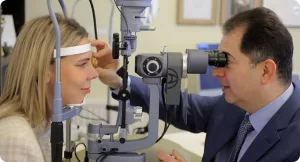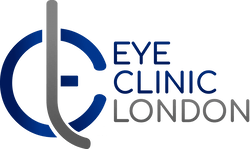ICL Eye Surgery Safety Explained: Real Results and What Studies Say

When you’re considering a procedure as life-changing as ICL (Implantable Collamer Lens) surgery, safety is likely at the top of your mind — and rightly so. Even though the promise of ultra-clear vision without the dryness of LASIK is enticing, the decision to go ahead hinges on one crucial question: how safe is it really?
Let’s unpack what the latest research says, explore real-world outcomes, look at how risks are managed, and explain why choosing the right surgeon can make all the difference. If you’re thinking about ICL eye surgery, this guide will give you a grounded, research-based look at what to expect.
What Is ICL Eye Surgery?
ICL stands for Implantable Collamer Lens — a type of vision correction surgery that involves placing a synthetic lens inside your eye, between your iris and your natural lens. Unlike LASIK or PRK, which reshape your cornea permanently, ICL adds a lens without altering your eye’s structure. It’s reversible, minimally invasive, and designed to stay put long-term — unless removal is medically necessary.
It’s often recommended for people with high levels of myopia (nearsightedness), thin corneas, or dry eyes — situations where laser eye surgery may not be suitable.
A Brief History of ICL Safety
The ICL has been around since the 1990s, and over the decades, its design has evolved dramatically. The introduction of the latest EVO+ Visian ICL, which includes a central port to allow natural fluid flow, has significantly improved the safety profile. Earlier models required a small hole to be made in the iris (called a peripheral iridotomy) to prevent pressure build-up. This step is often no longer necessary with newer models.
The CE Mark in Europe and FDA approval in the US — both granted after extensive clinical trials — show that the technology meets high regulatory standards. But what does current research say?
What the Latest Research Says About ICL Safety
- Low Complication Rates in Peer-Reviewed Studies
Recent data has consistently shown low rates of serious complications with ICL. A 2023 study published in Clinical Ophthalmology followed 1,000 eyes over three years and found that over 98% of patients achieved 20/40 vision or better — with zero cases of vision-threatening complications.
Other studies echo this. For example, a multicentre European trial found that only 0.2% of ICL patients needed lens removal due to complications like cataracts or elevated intraocular pressure. Compare this with the much higher revision or retreatment rates seen in LASIK patients with high prescriptions, and the ICL’s safety advantage becomes clear. - EVO ICL Models Reduce Need for Pre-Treatment
The EVO model’s central port has changed the game in terms of safety. By allowing aqueous humour (the fluid inside the eye) to flow naturally, the EVO ICL reduces the risk of pupillary block — a potentially serious complication. Several studies show this advancement has eliminated the need for laser peripheral iridotomies in most cases, streamlining the procedure and reducing patient anxiety. - Stable Outcomes Over Time
One long-term study tracked ICL patients for 7–10 years and found that the lens remained stable, with no significant shifts in vision or refractive error. Cataract formation — a concern in older ICL designs — occurred in fewer than 1% of cases and typically many years after surgery, suggesting it may have been age-related rather than ICL-induced.
Real-World Outcomes: What Patients Are Experiencing

- High Satisfaction Rates
Real-world patient feedback often mirrors what the clinical trials suggest: satisfaction rates for ICL are among the highest of any elective eye procedure. In a recent survey of over 500 ICL patients, more than 95% said they would choose the procedure again. Many report crystal-clear vision, especially in low-light settings — one area where LASIK can sometimes underperform due to issues like halos and glare. - Low Reversal Rates
Because ICL surgery is reversible, you might assume more people opt to have the lenses removed over time. But this isn’t the case. Studies show that ICL explantation is extremely rare, typically under 1% over a 5–10 year period. When it does occur, it’s usually due to unrelated eye issues like age-related cataracts rather than the lens itself. - Fewer Dry Eye Complaints
Dry eye is one of the most common complications of laser eye surgery, but ICL surgery doesn’t disrupt the corneal nerves in the same way. As a result, real-world reports of dry eye post-ICL are far lower, making it an excellent option for people who already have this issue or are prone to it.
Risk Management: What Could Go Wrong — And How It’s Prevented
No procedure is completely without risk, but ICL’s risk profile is well-understood and highly manageable when done properly.
- Avoiding Narrow-Angle Glaucoma
One potential concern is narrow-angle glaucoma, where the ICL could reduce the space between your iris and cornea, impeding fluid drainage and causing a dangerous pressure spike. This is why comprehensive pre-operative measurements are so critical. Surgeons will assess your anterior chamber depth, white-to-white distance, and vault space before going ahead.
If your anatomy doesn’t provide enough room, you won’t be offered the procedure. It’s as simple as that. - Cataract Formation
Though rare, anterior subcapsular cataracts can develop in a small percentage of ICL patients. This risk is more common in older individuals or those with shallow anterior chambers. Again, careful screening helps avoid this — and with the latest lens designs, the risk is further reduced.
If a cataract does develop, the ICL can be removed and traditional cataract surgery performed without issue. - Infection and Inflammation
As with any intraocular surgery, there’s a small risk of infection (endophthalmitis) or inflammation. But sterile surgical technique, post-op antibiotics, and anti-inflammatory drops significantly reduce this risk. Most modern ICL centres report infection rates close to zero.
Why Surgeon Experience Matters More Than You Might Think

This cannot be overstated. ICL is a highly technical procedure requiring precision and familiarity with your unique eye anatomy. Outcomes are significantly better in the hands of experienced refractive surgeons.
- Precision Sizing and Placement
Unlike off-the-shelf glasses or even LASIK, ICL requires the lens to be sized specifically to your eye. A miscalculation in lens sizing can result in complications like over-vaulting or under-vaulting, which may require replacement or repositioning. A seasoned surgeon with hundreds (or thousands) of procedures under their belt is much more likely to get this right first time. - Better Handling of Complex Cases
Not all eyes are textbook. Some have anatomical challenges, high refractive errors, or previous surgical history. An experienced surgeon will know how to adapt — and, just as importantly, when not to proceed. They’ll also be more comfortable managing any post-op issues if they do arise. - Transparent Aftercare Plans
A high-quality surgeon will also offer comprehensive follow-up, rather than a one-and-done approach. This means regular monitoring of pressure levels, lens position, and vision quality — all crucial for long-term safety.
Who Should Not Have ICL Surgery?
Just as important as knowing who’s a good candidate is knowing who isn’t. You may not be suitable for ICL surgery if:
- Your anterior chamber depth is too shallow (usually under 2.8 mm)
- You have a history of chronic uveitis or iritis
- You’re over 45 and already showing signs of early cataract formation
- You have uncontrolled eye diseases such as glaucoma or diabetic retinopathy
- You’re pregnant or breastfeeding (due to vision changes during pregnancy)
Your surgeon will go through a detailed screening process to rule out any of these issues.
How ICL Compares to LASIK and PRK in Terms of Safety
So how does ICL stack up to other vision correction procedures?
ICL vs LASIK
ICL tends to have a lower rate of retreatment for high myopia and avoids flap-related complications or corneal thinning. It’s also reversible — which LASIK is not.
ICL vs PRK
PRK avoids the flap issue but can result in longer healing times and more discomfort. ICL offers faster visual recovery and better comfort in the short term.
In terms of safety, all three procedures are considered low risk when performed by qualified surgeons — but ICL holds a unique advantage for patients who are not good candidates for laser procedures.
Long-Term Monitoring After ICL Surgery

Post-op care doesn’t end after a week. Your surgeon should schedule regular follow-ups to:
- Check intraocular pressure (especially in the first month)
- Monitor lens vault and positioning via OCT imaging
- Watch for early signs of cataract or endothelial cell loss
Most patients are checked at 1 day, 1 week, 1 month, 6 months, and then annually. If any issues are caught early, intervention is often simple and effective.
FAQs: ICL Eye Surgery Safety
- Is ICL eye surgery FDA-approved?
Yes, ICL surgery — particularly the EVO Visian ICL — has been approved by the FDA in the United States after rigorous clinical trials demonstrated its safety and efficacy. It’s also CE-marked in Europe, meaning it meets strict international health and safety standards. These approvals reflect strong supporting data across thousands of procedures worldwide. - How long does the ICL lens stay in your eye?
The ICL lens is designed to remain in your eye permanently, providing long-term vision correction. However, one of its key benefits is that it can be removed or exchanged if necessary, such as in the event of age-related cataracts or a significant change in prescription. Most patients never need to have it removed. - What’s the risk of going blind from ICL surgery?
The risk of severe vision loss from ICL surgery is extremely low when performed by a trained and experienced surgeon. Complications like infection or elevated pressure are rare and typically identified and treated early during follow-up visits. No procedure is entirely without risk, but blindness from ICL is exceedingly uncommon. - Can ICL cause glaucoma?
ICL can contribute to elevated intraocular pressure if the lens is too large or obstructs fluid flow, but this risk has been significantly reduced with the newer EVO lens design, which includes a central port. Comprehensive pre-op screening helps prevent this, and your surgeon will not proceed if your anatomy isn’t suitable. - Is the ICL visible to other people?
No, the ICL sits behind the coloured part of your eye (the iris), so it’s not visible to others. Even under close examination, it’s difficult to detect without special ophthalmic equipment. Most patients – and their friends and family – would never know it’s there unless told. - Will I feel the lens inside my eye?
After healing, you won’t feel the ICL at all. It’s made from a soft, biocompatible material that integrates naturally with your eye, and it doesn’t move around. Patients often report forgetting it’s there entirely, especially once they start enjoying the clarity of their new vision. - Can I have an MRI with an ICL lens?
Yes, the ICL is made from a non-metallic, MRI-safe material called collamer. It’s approved for use with MRI scanners up to 3 Tesla, which covers most standard hospital scans. However, it’s still good practice to inform your radiologist before undergoing any imaging procedure. - Is ICL safer than LASIK?
For certain individuals, particularly those with thin corneas or high prescriptions, ICL may be a safer choice because it doesn’t involve cutting or reshaping the cornea. While both procedures have excellent safety records, ICL offers the added benefit of being reversible, which gives it an edge for some patients. - How soon can I return to work after ICL surgery?
Most people can return to work within 2–3 days after ICL surgery, depending on the nature of their job. Vision usually stabilises quickly, and discomfort is minimal. However, it’s essential to follow your surgeon’s instructions and attend all follow-up appointments to ensure a smooth recovery. - Are there any lifestyle restrictions after surgery?
Immediately after surgery, you’ll need to avoid activities that could strain your eyes or introduce bacteria, such as heavy lifting, swimming, or rubbing your eyes. These restrictions typically last a week or two, after which most patients return to their normal routines with no ongoing limitations.
Final Thoughts: So, Is ICL Eye Surgery Safe?
If you’ve made it this far, you’re probably starting to see the pattern. ICL eye surgery is safe — very safe — when performed on the right patient by a qualified, experienced surgeon. The data backs this up, and so do real-world outcomes. Complication rates are low, satisfaction is high, and advances like the EVO lens have improved safety even further.
That said, no surgery is completely risk-free. The key to a successful outcome lies in careful screening, expert surgical technique, and solid post-op care.
At Eye Clinic London, we offer in-depth consultations and work closely with you to ensure you’re a good candidate before moving forward. If you’re considering ICL surgery and want trusted, research-led advice — we’re here to help you make a confident, informed decision.
References
- Zhou, W., Liu, K., Zhao, Y., Zhu, Y. and Li, L., 2023. A comprehensive retrospective analysis of EVO/EVO+ implantable collamer lens (ICL) safety and outcomes in 225 eyes. BMC Ophthalmology, [online] 23(1), p.56. Available at: https://www.ncbi.nlm.nih.gov/pmc/articles/PMC10787571/ [Accessed 10 Jul. 2025].
- Luo, W., Song, D., Zhang, Y., Li, M. and Sun, Z., 2023. Four-year visual outcomes and optical quality of SMILE and implantable collamer lens (EVO-ICL) implantation for high myopia: a retrospective study. BMC Ophthalmology, [online] 23(1), p.312. Available at: https://www.researchgate.net/publication/372784039_Four-year_visual_outcomes_and_optical_quality_of_SMILE_and_implantable_collamer_lens_V4c_EVO-ICL_implantation_for_high_myopia_a_retrospective_study [Accessed 10 Jul. 2025].
- Fernández-Vega-Cueto, L., Lisa, C., Esteve-Taboada, J.J., Montés-Micó, R. and Alfonso, J.F., 2021. Intraocular pressure after EVO Visian ICL implantation. Clinical Ophthalmology, [online] 15, pp.4327–4334. Available at: https://www.ncbi.nlm.nih.gov/pmc/articles/PMC8645885/ [Accessed 10 Jul. 2025].

